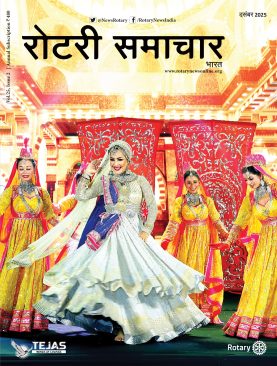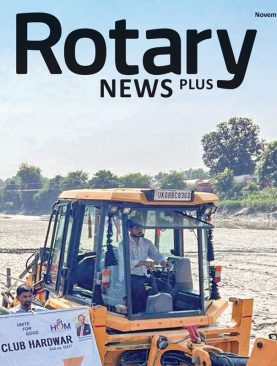At the Disha conclave held in Jaipur for the training of incoming district governors, DGNs and the district leadership teams from Zones 4 and 7, incoming RI Director K P Nagesh, who is in charge of these zones, asked the district leaders to aim high and take TRF-giving and membership to new highs during the next two years.

Through a series of charts and visual graphs he urged them to do their best to take India’s position in membership to No 1. Displaying a graphic on membership of Rotary in the world, he said: “Look at this chart; this will tell you what is the need of the hour in India. We are in No 2 position with 176,280 members, against the US which is No 1 with 273,149 members.”
Breaking down the numbers, he said the US had 153 Rotary districts, whereas India has only 42 districts. This meant that in the US there are 47 clubs in one district, against 111 clubs per district in India. Whereas the US had 1,785 Rotarians per district, in India we had a whopping 4,197 members in each district. “There is clearly an opportunity here, which we are not encashing. We are eligible to make three districts from each existing district,” he said.
If this opportunity was encashed, “we can have 100 representatives at the CoL, where so many important decisions are taken. We can have eight zones and four RI directors, as every two zones have one director.”
There are 111 clubs per district in India, and a whopping 4,197 members in each district. We are eligible to make 3 districts from each existing district.
— K P Nagesh, RI Director Elect
Nagesh said that while aiming at a membership figure of three lakh by June 2027, India has to work on the mantra “‘Divide to Multiply. Each of you must think how to grow big. Look at history; wherever a new district is formed, the growth is vertical, even in B class cities, be it Mysore or Pune. Pune is one of the best examples in membership growth.”
He told the DGEs that for their Rotary year 2025–26, they should religiously keep their focus on what he and his fellow RIDE M Muruganandam call Mission 2.25 lakh. Under this mission, they have to remember that all the DGEs have 365 days. On each day if one new club could be formed in Zones 4 and 7, and one in the other two Zones — 5 and 6, “then you can end your year with 730 clubs. If each club has an average of 30 members, then the 730 new clubs will have 21,900 new members.” The same could be repeated the next year and this would really boost Rotary’s membership in India, he added.

Coming to TRF-giving, RIDE Nagesh said the incoming district leaders should really set high goals. “Unless we set goals there will be no direction and without direction the fate of an organisation can be imagined. So in 2017, at the first Disha in Mumbai, initiated by the then RI Director C Basker, it was decided to have an annual goal-setting exercise. Thanks to this direction and focus, we have moved to a fixed No 2 position in TRF-giving and the No 1 position in membership growth, year-after-year. But our aim should be to move to the top position in both TRF-giving and total membership. After all membership is the key to the impact that our work can create, and both RIPE Mario de Camargo and RIPN Sangkoo Yun have been emphasising on membership growth.”
Nagesh added that for the first time, this year’s Disha conclave was being held in two parts — one each for two zones. While urging the DGEs to set high goals in both TRF-giving and membership, he assured them that these goals would be “achievable because each of you is a leader.”
He also reiterated that goals thus set would be time-bound and would get both awards and recognition. Giving an example on membership growth, Nagesh said, “We have about 800–900 assistant governors; imagine if each AG started a new club, we would have 900 clubs, and 27,000 new Rotarians.”

Addressing the delegates, RIDE M Muruganandam said that he began his Rotary journey more than three decades ago as a Rotaractor and “even before becoming a Rotarian I was a Major Donor. It is very simple, whenever you’re giving to TRF, don’t give unless you are convinced. But once you’re happy, keep giving, because you are giving to a 107-year-old Foundation that is doing so much good in the world.”
Quoting RIPN de Camargo, he said Rotary’s biggest asset is not its 120-year-old history but its members, and more members would mean more service to improve the world.
Elaborating on his topic Mission 2.25 lakh: The 1:2:3 growth formula, and sharing slides on awareness and knowledge about Rotary worldwide, he said a recent survey done by RI on the awareness of Rotary had shown that while the respondents in Taiwan emerged the largest at 91 per cent, India stood second at 83 per cent. In both the US and UK, the figure was a dismal 52 per cent each; in Japan it was 42 per cent and Korea only 33 per cent. But when it came to how familiar are you with the work that Rotary does, the figure for India was the highest at 73 per cent, followed by Nigeria at 57 per cent and Taiwan 54 per cent.

The incoming director said that even though India had a strong position in membership, there were major concerns. Presenting a number of charts on what he and RIPE Nagesh have devised… the RAG (Red, Amber, Green) analysis, he said a club could be classified green if it had 50 or more members. What we want are “bigger, bolder and better clubs”; amber if it had 25 to 50 members; and red if it had less than 25 members. His study had shown that of the two Zones 4 and 7 — for which this Disha was being held, in Zone 4, only 277 or 21 per cent of the clubs were in the green zone. While 376 clubs or 28 per cent were sitting in the amber zone, a disturbing number of 680 clubs or 51 per cent were in the red zone. “This means you are off the mark, please try and push these into the amber zone.”
The RAG analysis of Zone 7, which had 984 clubs, had shown that 328 or 33 per cent clubs were in the red zone, 395 or 40 per cent were in the amber zone and 261 or 27 per cent were in the green zone. “Please tell all your presidents to take the clubs from red to amber and amber to green,” he added.
When the other two zones — 5 and 6 — were included in this analysis, of the 1,329 clubs in Zone 5, 461 were in the red corner, 586 sat in the amber zone and only 282 had the green label. In Zone 6, of the 1,173 clubs, 590 were red, 282 amber and only 201 green.

Coming to the all-India statistics, of the total 4,819 clubs in India, 2,059 or 42 per cent clubs were in the red zone, 1,739 or 36 per cent were in amber, and only 1,021 or 22 per cent were in the green zone. “The fact remains that we are not growing… it is humbug to say we are!”
Next, coming to the membership trend and growth in Zones 4 and 7, the incoming director said that the members in Zone 4 had gone up from 39,776 in 2020–21 to 44,485 in 24–25. In Zone 7, during the same period, the numbers had risen from 35,457 to 39,454. The net growth in five years in both these zones was 9,066, or 1,813 members a year. “The math is simple, every year you are growing by 1,813, which means that a district is not even giving 100 extra members. Surely there was potential for more growth than this,” he added.
Coming to induction of youth into Rotary, Muruganandam said it was a pity that at a time when all senior RI leaders were talking about the need to make Rotary ‘young’, scant attention was being paid in India to boost Rotaract numbers. “The average age in this room is 50, and at this age we think only of two things, your health and your children. Please think of your kids as nothing other than Rotaractors and Interactors. If you want to see the Rotary Wheel for another 100 years, and do more service projects, think of Rotaractors and Interactors. Otherwise, we are killing our organisation.”
The average age in this room is 50, and at this age we think only of two things, your health and your children. Please think of your kids as Rotaractors and Interactors.
— M Muruganandam, RI Director Elect
Sadly enough, as many as 74 per cent of Rotary clubs had not sponsored even a single Rotaract club and 79 per cent clubs not even one Interact club. The best “youth service mechanism” for Rotary in India was for every Rotarian to get two Rotaractors and three Interactors. It was a pity that in Zone 4 out of 1,333 Rotary clubs, only 381 clubs had sponsored a Rotaract club. This meant that a whopping 71 per cent of the clubs (952 clubs) had not sponsored a single Rotaract club. Coming to Interact, only 410 clubs had formed an Interact club, with 923 (61 per cent) not doing so. Similarly, only 424 clubs had formed an RCC, with 909 (68 per cent) scoring a zero.
In Zone 7 too the picture was not much better. Of the 984 clubs, only 345 had sponsored a Rotaract club, 382 had sponsored an Interact club and 422 had started an RCC. In these three areas, 639 (65 per cent), 602 (61 per cent) and 562 clubs (57 per cent), had drawn a blank. “This is very unfortunate, there has been degrowth of Rotaract by over 22,000 members in five years,” he added.

The result was their numbers shrinking in Zone 4 from 25,561 in 677 clubs to 14,312 in 597 clubs in 2024–25. In Zone 7 too these numbers had shrunk from 21,003 in 692 clubs to 10,034 in only 598 clubs during the same period. The total number by which Rotaract had shrunk in these two zones was a disturbing 22,218, added Muruganandam.
He urged the incoming district leadership teams to concentrate in the coming years on setting up new clubs in all kinds of formats and follow the RAG analysis, moving red to amber and amber to green zones. “By doing this alone we can add 25,000 members a year and 50,000 in two years.”
Past RI Director A S Venkatesh admitted that the goals the assembled district leaders had been given were tough, but giving several examples and holding their attention through interesting anecdotes, he said if they focused on the huge opportunity that lay before them, they would succeed.
We are so trapped in our own achievements and laurels we have earned, that we fail to ask what the prospective members expect or are interested in.
— A S Venkatesh, Past RI Director
The earlier evening, one of the DGEs had expressed to him scepticism on there being too many training events. To this he responded with a statement attributed to Bruce Lee, who had said: ‘I don’t fear a person who knows 1,000 tricks but only the person who knows only one trick but has practised it 1,000 times.’
“Your efficiency, efficacy and impact all depends on how well you are tuned and that happens only through repeated training. Famous cricketer Ricky Ponting’s cover drive may be a treat to watch and looks effortless but what lies behind it must be that he’d have practised his cover drive 20,000 times in the nets. That is not visible when he is on the field.”
Similar was the case with all leaders about to take on their roles. “You have to hone your skills really hard in order to deliver. All of us have chosen to take on a role in Rotary willingly. Each one of us had a chance to say ‘No’; nobody can say I was pushed into it. You have taken up the governor’s role voluntarily, and now you will have to do many things to make it a success.”

When it came to membership, it was crucial to ask the prospective members the right questions such as what they would like to do. “We are so trapped in our own achievements and laurels we have earned, that we fail to ask what do they expect or are interested in. If you have to achieve targets never achieved before, you have to do things differently.”
Venkatesh added: “Don’t be shy about asking others to join Rotary. We have 176,000 Rotarians in India, even if 20 per cent, or 35,000 ask a person once a week, that is 50 times a year, and even if the conversion rate is only 10 per cent, imagine how many new members we will get. If you wait for people to come and look at our achievements, bill boards, t-shirts, and ask to join Rotary that is not going to happen.”
Underlining the importance of passion and focus, he related a story from Alibaba co-founder Jack Ma’s biography, saying that when a person is locked for 30 minutes in a room with 50 rabbits, and is challenged to catch one, over 90 per cent fail to do so. This was because he’d invariably try to catch the rabbit near his feet, and if that one runs away, the next closest one and so on, till the time runs out. The trick is to focus on only one rabbit, chase it till you catch it, without letting the mind being diverted by the other 49 rabbits.
The same thing happens with many Rotary leaders; they get attracted to one project, and then another catches their fancy. At the end of the year little is achieved. Once again quoting from Ricky Ponting’s biography Venkatesh said when the great cricketer was once asked if he mapped the fielders where he was out batting, he had said: ‘No, I map the gaps in the field and not the fielders! So are we looking at the opportunities or the hurdles? The gaps are the opportunities and the fielders are the hurdles. There are plenty of opportunities out there.”
He then gave the example of the legendary donor to TRF, Ravishankar Dakoju from Bengaluru; “he has a single-minded focus on the environment and once approached me for seed ball manufacturing. I connected him with somebody in his city and then forgot about it.”
But Dakoju didn’t forget, he came back and said: ‘Venky, that didn’t work out. You still have to give me the right connect.’ And next week it will be hopefully done. That is the kind of single-minded focus you will need. There will be hurdles, but you will have to move past them. You’ve been asked to focus on something which has never been done before, so there will be hurdles/problems but the choice is yours, will you look at the hurdles or the opportunities?”
Some of the interesting topics covered during the three-day event included a talk by PDG S Nagendra on how to strengthen women’s role in Rotary, particularly in leadership position. Many opportunities exist to increase Rotary’s membership in India by getting more women. “We have to change the mindset and perception that Rotary is male dominated. Unfortunately, there was a limitation in leadership roles for women, as well as cultural and social barriers, which you will have to address.”
New strategies were needed to look for women members; he advised them to concentrate on hospitals where there were more women doctors, educational institutions with sizable women faculty members, and women’s organisations.
PDG Sam Movva told the incoming governors that there were novel ways to boost TRF-giving and one of these was the Bequest Society, where members could perpetuate their families’ names by donations in various ways. There are 43 such organisations in Zones 4 and 7. “A bequest is a commitment of at least $10,000, and one of the most popular ways of giving is through insurance… this year a committee has been formed under TRF Trustee Bharat Pandya’s leadership to look at garnering various policy instruments. The agencies chosen are LIC, Kotak Mahindra and Axis Max.” A bequest can also be made through equities, mutual funds and wills, he added.
Disha chairman PDG Rajesh Agarwal said retention was as important as adding new members. “That is the biggest challenge, you will have to ensure that every existing member feels valued… are we doing enough to ensure each member in our clubs is enjoying all aspects of Rotary?”
Programme coordinator PDG Suresh Hari explained the process of strategic goal-setting, and urged the DGEs to aim high in setting their goals and then work hard to achieve them.
Conference secretary PDG Anil Agarwal, focusing on the DRRs in the room, said in order to infuse young blood into Rotary, district leaders would have to focus on Rotaractors. “If you really want to make yourself leadership efficient, and Rotary a much better place, you will have to focus on Rotaractors and Interactors.”
Pictures: Rasheeda Bhagat





